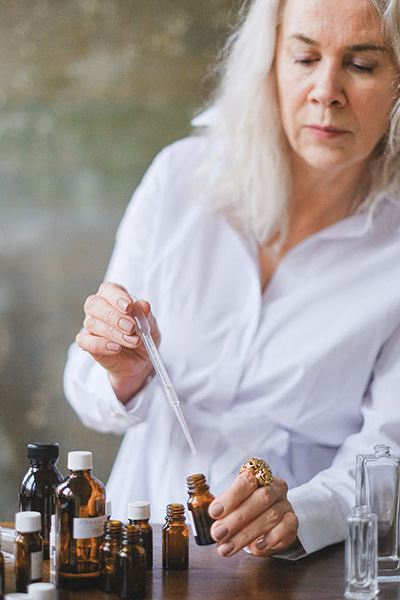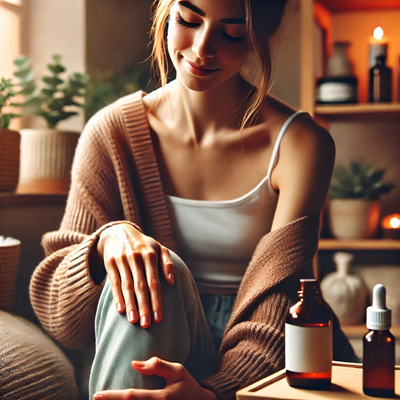Contents
A natural secret weapon lurks in your pharmacy (or maybe just waiting to be ordered): essential oils for muscle soreness. These potent plant-based elixirs aren’t just for diffusing dreamy scents – they’re packing a punch for soothing aches and pains.
Have you ever woken up feeling like you used your muscles as pillows in a pillow fight? That post-workout ache, lingering tightness after yard work, nagging stiffness from sleeping funny – muscle soreness can turn even the simplest movements into an Olympic hurdle.
Imagine ditching the ibuprofen and reaching for a roller bottle filled with the refreshing tingle of peppermint, the calming embrace of lavender, or the warming comfort of rosemary. These are just a few essential oils for muscle soreness that can turn your frown upside down (and your stiffness into supple).
So, ditch the struggle and get ready to rediscover the joy of pain-free movement! Dive into this guide and unlock the secrets of using essential oils for muscle soreness. We’ll explore the most effective oils, whip up some DIY blends, and offer bonus tips for ultimate recovery. By the end, you will know how to effectively manage muscle soreness and confidently regain your body’s natural energy.
A Deep Dive into Essential Oils for Muscle Soreness

When muscle soreness rears its unwelcome head, throwing everyday movements into a slow-motion nightmare, it’s natural to crave relief. Thankfully, Mother Nature offers a secret weapon in her botanical arsenal: essential oils for muscle soreness. These potent plant-based extracts act as influential supporters in the fight against aches and pains, offering a safe and effective alternative to orthodox pain relievers. But with a dizzying array of oils lining the shelves, which ones truly rise to the challenge? Buckle up because we’re about to unleash the powerhouses of pain relief in the essential oil world!
Peppermint: This icy champion, bursting with menthol, isn’t just for after-dinner mints. When diluted and applied topically, peppermint oil delivers a refreshing wave of coolness that numbs aching muscles and boosts circulation. This helps improve blood flow and speeds up the removal of lactic acid. This waste product leaves muscles feeling like overcooked spaghetti. Studies have shown peppermint’s effectiveness in reducing delayed onset muscle soreness (DOMS), that familiar post-workout ache that makes climbing stairs feel like scaling Everest. So, the next time your legs scream after a strenuous hike, reach for the refreshing tingle of peppermint –a natural ice pack in a bottle!
Lavender: Renowned for its calming fields and soothing scent, lavender oil is more than just a sleep aid. Its anti-inflammatory and analgesic properties work wonders on tense muscles. This gentle giant helps quell muscle spasms, reducing that tight, knotted feeling that turns simple stretches into contortions. Lavender’s calming aroma is a stress reliever, further promoting muscle relaxation and restful sleep – crucial for optimal recovery. So, whether you’re battling post-workout tension or chronic muscle stiffness, lavender offers a soothing embrace that melts away physical and mental aches.
Rosemary: This aromatic herb isn’t just for seasoning your roast. Rosemary oil is a circulation champion, stimulating blood flow to deliver oxygen and nutrients to tired muscles. This boost in cellular activity accelerates the healing process, reducing inflammation and easing that nagging soreness. Research even suggests rosemary’s efficacy in reducing markers of muscle damage, making it a potent ally for athletes and weekend warriors. So, don’t underestimate the power of this culinary crusader – rosemary oil is a powerful weapon in your muscle-relieving arsenal.
Eucalyptus: This refreshing aroma isn’t just for decongesting stuffy noses. Eucalyptus oil boasts powerful analgesic and anti-inflammatory properties, acting as a natural pain reliever for aching muscles. Its stimulating effect increases blood flow and oxygen delivery, removing lactic acid and promoting faster recovery. Research even suggests its effectiveness in managing chronic muscle pain and joint stiffness, relieving arthritis. So, next time your joints feel like rusty hinges, eucalyptus oil can bring back the smooth glide of pain-free movement.
The botanical world holds a treasure trove of other muscle-soothing allies, such as:
- Chamomile: Its calming properties ease muscle tension and inflammation, offering gentle relief for sensitive areas.
- Marjoram: Known for its warming and relaxing effects, marjoram oil helps loosen tight muscles and reduce spasms.
- Ginger: This spicy oil boasts anti-inflammatory properties, making it an outstanding choice for soothing sore muscles and stimulating circulation.
While essential oils naturally help muscle soreness, Safety is paramount. Always combine them with carrier oils like coconut or jojoba before applying them topically. Patch test on a small area before widespread use, and avoid essential oils for muscle soreness during pregnancy or breastfeeding. Consulting a healthcare professional or qualified aromatherapist for personalized guidance is always recommended. But beyond the oils themselves, unlocking their muscle-relieving magic lies in synergy.
DIY Essential Oil Blends for Targeted Muscle Relief
The upside of essential oils for muscle soreness lies in their incredible versatility. Just like spices in a kitchen, you can combine different oils to create potent blends tailored to specific needs. Regarding muscle soreness, crafting synergistic blends unlocks a new level of targeted relief.

Post-Workout Recovery Blend:
- Peppermint (3 drops): Its cooling menthol sensation eases inflammation and numbs aching muscles.
- Rosemary (2 drops): Stimulates circulation, delivering oxygen and nutrients for faster healing.
- Lavender (2 drops): Calms muscle tension and promotes relaxation, aiding recovery and restful sleep.
Merge these oils in a 10ml roller bottle with jojoba oil as your carrier. Massage the blend onto sore muscles after workouts, focusing on areas like legs, shoulders, and back. The refreshing aroma and invigorating tingle will signal the start of your recovery.
Neck Tension Tamer Blend:
- Clary sage (2 drops): Relaxes muscle spasms and eases tension headaches; perfect for knotted necks.
- Marjoram (2 drops): Offers warmth and gentle muscle relaxation, relieving tightness.
- Roman chamomile (2 drops): Soothes inflammation and calms nerves, reducing stress and tension.
Mix these oils in a 5ml roller bottle with sweet almond oil as your carrier. Gently massage the blend onto your neck and shoulders throughout the day to melt away tension and restore peace to your upper body.
Deep Tissue Rejuvenator Blend:
- Cypress (2 drops): Its warming properties improve circulation and ease stiffness in more profound muscle layers.
- Black pepper (1 drop): Offers analgesic and anti-inflammatory properties, ideal for chronic muscle pain.
- Ginger (1 drop): Boosts circulation and reduces inflammation, particularly effective for joint aches.
Blend these oils in a 5ml roller bottle with grapeseed oil as your carrier. Apply this blend sparingly to areas with chronic pain or stiffness, like knees, elbows, or lower back. Remember, black pepper oil is potent, so dilute it well and avoid large application areas.
These are just a starting point! Experiment with different carrier oils to find what works best for you. Consistently execute a patch test before applying a new blend and keep safety guidelines in mind. With creativity and caution, you can unlock the incredible potential of DIY essential oil blends for targeted muscle relief!
Complementary Strategies for Ultimate Muscle Recovery

While essential oils for muscle soreness offer a powerful punch, proper recovery is a multi-pronged approach. These potent plant allies work best when paired with additional practices that nurture your body’s natural healing potential.
Proper Hydration: It’s no secret that water is vital for optimal bodily function, and muscle recovery is no exception. Dehydration hinders circulation and nutrient delivery, making muscles more susceptible to soreness and stiffness. Aim for eight cups of fluids daily and even more after strenuous activity. Infused water with cucumber or berries adds a refreshing twist and boosts your vitamin intake. Remember, your body is a temple, and proper hydration is the foundation for its smooth operation.
Stretching Superhero: Gentle stretching after exercise and throughout the day can work wonders for muscle recovery. Focus on dynamic stretches that mimic your workout movements and hold static stretches for 30-60 seconds. Regular stretching improves flexibility, reduces muscle tension, and promotes blood flow, all contributing to a faster bounce-back from soreness. Invest in a foam roller for self-massage, targeting tight spots and releasing trigger points for additional relief.
Restful Renaissance: Sleep is your body’s ultimate repair shop. When you’re slumbering, your muscles rebuild and repair, making sufficient rest crucial for recovery. Aim for seven to eight hours of worthwhile sleep each night, creating a peaceful bedtime routine and minimizing screen time before hitting the hay. A refreshing nap after a particularly intense workout can also accelerate your muscle’s recovery.
Professional Partners: For persistent pain or chronic muscle issues, seeking professional guidance can be invaluable. Consulting a physical therapist can help identify underlying soreness causes and recommend targeted treatment plans. A Qualified massage therapist can also work their magic on tight muscles, releasing tension and promoting deep-tissue healing. Remember, there’s no humiliation in seeking professional help – it’s a sign of taking your well-being seriously and investing in your long-term health.
By blending the power of essential oils for muscle soreness with these complementary strategies, you create a symphony of relief that orchestrates a speedy and complete muscle recovery. So, listen to your body, nourish it with hydration and rest, move it with mindful stretching, and don’t hesitate to seek advice when needed. Remember, you are the conductor of your overall health – tune in, harmonize your practices, and get ready to dance pain-free!
By understanding these key points and incorporating additional natural strategies, you can unlock the full potential of essential oils for muscle soreness and create a holistic approach to your overall health. Knowledge is power, so keep exploring, experimenting, and listening to your body. With dedication and natural remedies, you can say farewell to aches and pains and embrace a life of pain-free movement and vibrant health!
Health Disclaimer: The information on this website is for educational uses only and is not a substitute for professional medical advice. Always consult an authorized healthcare provider for any health concerns before using any herbal or natural remedy. We do not establish, treat, cure, or prevent any disease. Reliance on any material from this website is solely at your own risk. We are not responsible for any adverse effects resulting from the use of information or products mentioned on this website.
References
- Ozgoli, G., Goli, M., & Moattar, F. (2013). Comparison of effects of topical application of sweet almond oil and marjoram essence on delayed onset muscle soreness in untrained volunteers. Journal of Bodywork and Movement Therapies, 17(2), 167-171.
- Black, C. D., Herring, M. P., Hurley, D. J., & O’Connor, P. J. (2010). Ginger (Zingiber officinale) reduces muscle pain caused by eccentric exercise. The Journal of Pain, 11(9), 894-903.
- Han, X., Gibson, J., Eggett, D. L., & Parker, S. M. (2012). Rosemary aroma significantly affects cognitive and physical performance in healthy adults. Journal of Alternative and Complementary Medicine, 18(7), 635-643.
- Kim, S., Lee, B., & Choi, J. (2013). Effects of aromatherapy on muscle fatigue and delayed-onset muscle soreness in high-intensity exercise. Journal of Exercise Rehabilitation, 9(4), 442-447.
- Peana, A. T., D’Aquila, P. S., Panin, F., Serra, G., Pippia, P., & Moretti, M. D. L. (2002). Anti-inflammatory activity of linalool and linalyl acetate constituents of essential oils. Phytomedicine, 9(8), 721-726.
- Eccles, R. (2009). Menthol and related cooling compounds. Journal of Pharmacy and Pharmacology, 61(8), 997-1007.
